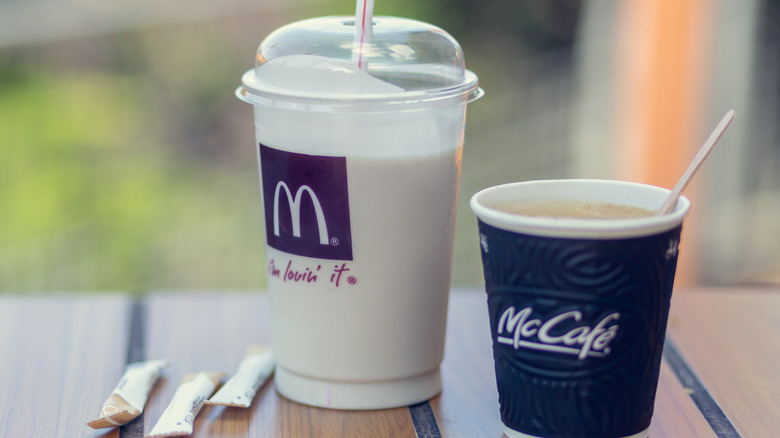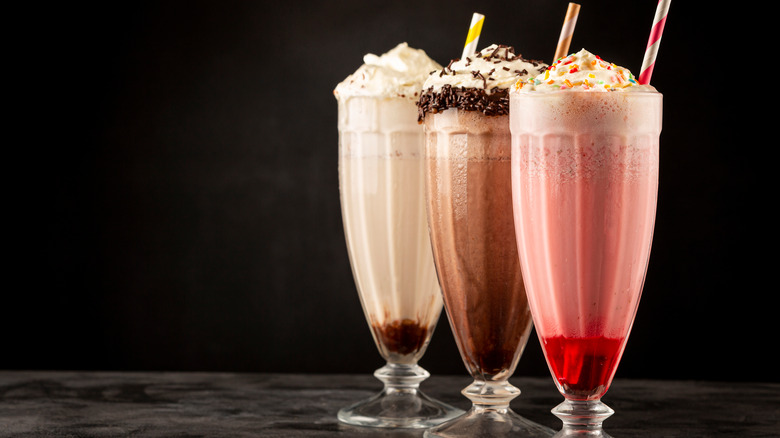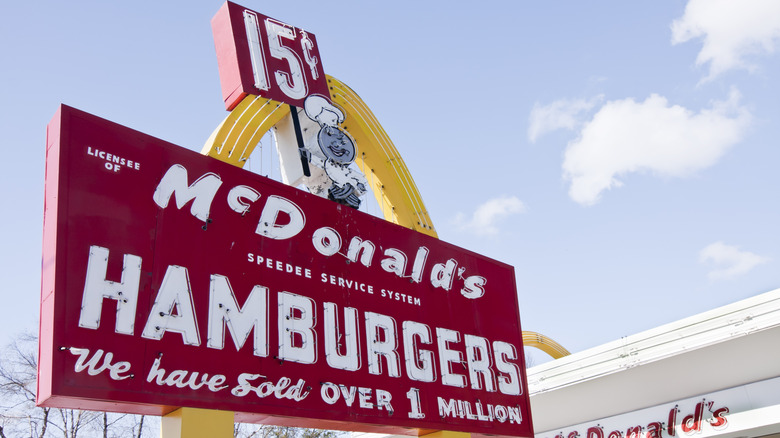Why You're Technically Not Able To Order A Milkshake At McDonald's
Just about everyone knows that McDonald's has shakes on its menu. A simple visit to the fast food giant's website will show them clear as day: vanilla shake, chocolate shake, and strawberry shake. That's on top of the seasonal or limited-time-only variants, like the fan-favorite Shamrock Shake, or the Grimace Shake. You will, however, notice that the word "milk" is pointedly missing from "shake." This isn't just a matter of colloquialism. It's that McDonald's shakes cannot technically be categorized as milkshakes.
The word "milkshake" is in fact a legal category. McD's stipulates this on its website, making clear that state-to-state dairy regulations vary widely. Ergo, rather than figure out where McDonald's can or cannot legally put "milkshake" on their menu, they simply call their milkshake-like concoctions "shakes."
To be clear, this does not mean that McDonald's shakes are made without milk. The very first ingredient listed in a vanilla shake is reduced-fat vanilla ice cream. That's also true for the chocolate and strawberry shakes. But what is done with the actual dairy content of an item –- specifically a frozen dessert –- has a lot of bearing on how it can be described in legal terms.
So what makes a milkshake a milkshake?
There is, of course, a national body of governmental dairy regulation in the United States, and it's the same body responsible for ensuring all food safety: the Food and Drug Administration. However, when it comes to dairy, the FDA does not directly regulate or enforce. That role is down to the states, with the FDA providing assistance.
This means that on many issues pertaining to dairy products, each state can decide its own specific regulations and definitions, including what goes into a milkshake. For example, Pennsylvania defines a "freezer-made milk shake" as containing somewhere between 3.25% and 6% milk fat, and no less than 10% non-fat milk solids. "Freezer-made shakes" that don't conform to these guidelines cannot be advertised as milkshakes. But if that milkshake you purchased in Philadelphia somehow makes it to New York City, and it was made with 10% exactly in solids, it is no longer legally defined as a milkshake. That's because New York defines a "dairy shake" as containing no less than 3.25% milk fat and no less than 11% non-fat milk solids. It's a slight difference, but meaningful if you are trying to ship your ingredients and products across state lines. Which, of course, McDonald's is.
Other fast food chains also use different terms for their shakes
McDonald's has had some sort of shake on their menu since at least 1949. According to their official history, they were at the time called Triple Thick Milkshakes. That, however, was a long time ago, before McD's had become a national chain, and when it had a single location in San Bernardino, California.
Today, McDonald's shakes are made with the chain's soft serve ice cream mix, which is where the aforementioned reduced-fat vanilla ice cream comes in. But while the McDonald's website refers to its soft serve as ice cream, the shakes made with that ice cream don't qualify as milkshakes in every one of the 50 United States.
These state-by-state regulations don't just pertain to McDonald's, of course, and it isn't the only chain that calls its milkshakes something other than milkshakes. Sonic, Del Taco, and Burger King all call their milkshakes "shakes." Wendy's, meanwhile, calls its own concoction the Frosty. Even Dairy Queen –- a chain that built its reputation on frozen dairy desserts –- has to play the shake game.


